Huge ice chunks stacked some 8 feet deep on Lake Superior have left 18 freighters stuck. The U.S. and Canadian Coast Guards have gotten involved, sending Canadian icebreakers and American vessels to help the ships break free from Whitefish Bay.
Mark Gill, director of Vessel Traffic Services for the U.S. Coast Guard at Ste. Saint Marie, Mich., told NPR's Melissa Block that the ice has created a traffic jam on the water. "Imagine an interstate highway where you've got a north- and a southbound lane," Gill said. "And there's a bridge that passes over a waterway, and that bridge is out, so traffic going north, traffic going south, can't move until that bridge is repaired — that's kind of what we're up against here."
Gill says weather is partly to blame. "Two weeks ago in Lake Superior, the lake was roughly 75 percent covered in ice," said Gill. "[With] warmer temperatures, that ice has begun to break free from the shoreline, and then we had a wind event last week where the westerly winds took all of that free-floating ice and has packed it into the eastern end of Lake Superior."

That ice has gotten packed pretty densely. "Whitefish Bay is 100 percent covered with ice that is 3 feet thick," said Gill. "The ice in Lake Superior has pressed up against this firm ice edge in Whitefish Bay and has started to roll up on itself, and it's created a roughly 35-square-mile field of ice. Some of the chunks that have come out of Lake Superior are pickup truck-sized. And those chunks that are that size are stacked on top of each other, they've reached a thickness of 8 feet."
Gill says as a result, six eastbound ships and 12 westbound ships, carrying mostly iron ore and coal, are blocked. "They're waiting in a holding pattern while we clear a path to get them through this field of ice." So far, two of those ships have started to make their way out of the ice with the help of a Canadian coast guard ship. A Canadian "arctic breaker" has been brought down to join the effort as well.
Gill told NPR that the ships have to clear a path for the freighters to get out of the ice. "It's not so much a breakup," he said. "You're picking through it till you find openings, and you're kinda shoving pieces away as you make your way through. By working side to side, you open it up, so that the ships that are kind of following you into it. You're literally creating an open space, and then sliding forward, and then an open space, and sliding forward."
The work can be dangerous, says Gill. "It's very tedious," he said. "And it's risky, 'cause at night, you can't see, and so you're almost at the behest of Mother Nature there as she blows her winds on it. Some of the pieces are jagged. One of the ships took a hole in one of its ballast tanks."
But Gill says for the most part, all parties involved have managed to keep their calm through the entire ordeal. "Time is money for these vessels, so they want to know when they're moving. Generally, it's calm, cool, and collected," he said. "Occasionally people's frustration gets the better of them and they get some flare-ups. But for the most part, it's civil."
Copyright 2021 NPR. To see more, visit https://www.npr.org.




